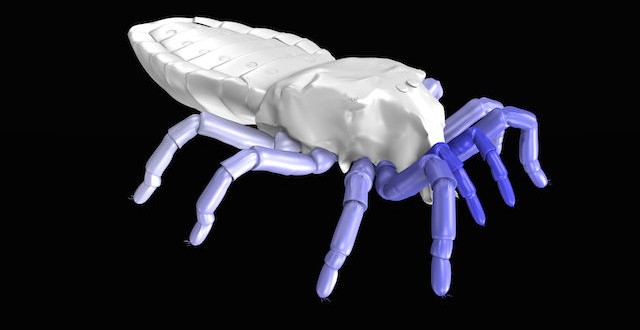A new video based on fossils of a 410-million-year-old arachnid uses computer animation to recreate the animal walking. The arachnid belonged to the extinct order Trigonotarbida, and was a member of the Devonian genus Palaeocharinus, which was one of the first predators on land.
Scientists from the University of Manchester and the Museum für Naturkunde used exceptionally preserved fossils from the Natural History Museum in London to create the video, which shows the most likely walking gait of the animal. The video accompanies a study published in the Journal of Paleontology.
The researchers used the fossils — thin slices of rock showing the animal’s cross-section — to work out the range of motion in the limbs of this ancient, extinct early relative of the spiders.
From this, and comparisons to living arachnids, the researchers used an open source computer graphic program called Blender to create the video showing the animals walking.
“When it comes to early life on land, long before our ancestors came out of the sea, these early arachnids were top dog of the food chain,” said author Dr Russell Garwood, a palaeontologist in the University of Manchester’s School of Earth, Atmospheric and Environmental Sciences. “They are now extinct, but from about 300 to 400 million years ago, seem to have been more widespread than spiders.
Now we can use the tools of computer graphics to better understand and recreate how they might have moved — all from thin slivers of rock, showing the joints in their legs.”
Co-author Jason Dunlop, a curator at the Museum für Naturkunde, Berlin, said: “These fossils — from a rock called the Rhynie chert — are unusually well-preserved. During my PhD I could build up a pretty good idea of their appearance in life. This new study has gone further and shows us how they probably walked. For me, what’s really exciting here is that scientists themselves can make these animations now, without needing the technical wizardry — and immense costs — of a Jurassic Park-style film.
“When I started working on fossil arachnids we were happy if we could manage a sketch of what they used to look like; now we can view them running across our computer screens.”
This work is part of a special collection of papers on three-dimensional visualisation and analysis of fossils published in the Journal of Paleontology.
Dr Garwood added: “Using open-source software means that this is something anyone could do at home, while allowing us to understand these early land animals better than ever before.”
Agencies/Canadajournal
 Canada Journal – News of the World Articles and videos to bring you the biggest Canadian news stories from across the country every day
Canada Journal – News of the World Articles and videos to bring you the biggest Canadian news stories from across the country every day



